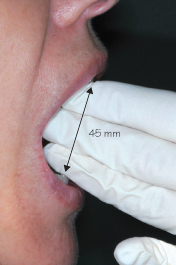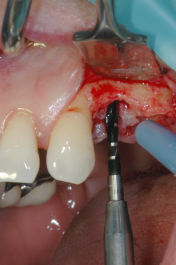18
Patient evaluation: surgical considerations
Before surgery, a clinical examination must be carefully conducted and cannot be replaced solely by a radiographic examination. A comprehensive patient examination is mandatory to anticipate surgical complications.
Surgical Accessibility
Mouth opening: a minimum of 40–45 mm (about three fingers’ width) is required to allow access to the posterior area of the mouth for drills and implants, while respecting prosthetic guidelines (Fig. 18.1). A limited mouth opening will compel the surgeon and prosthodontist to use short instruments, short implants or tilted implants. In extreme situations, implant therapy can be contraindicated.
Figure 18.1 A minimum of 40–45 mm of mouth opening is required for surgical and prosthetic accessibility.

Teeth adjacent to the implant site can interfere with correct positioning of drills (bumping of the handpiece). The use of a drill extension may be required, but is not always possible in the posterior area (Fig. 18.2).
Figure 18.2 A drill extension may be necessary to avoid contact between the handpiece and the adjacent teeth, without altering the drilling direction.

Surgical access should be tested before confirming the surgery appointment.
Esthetic Complexity (See Chapter 17)
Soft tissue manipulation during implant surgery of the anterior area can have detrimental consequences for patients with thin biotype or multiple planned surgeries. Evaluation of the esthetic surgical complexity is essential. Complex situations require the most predictable therapeutic options (Table 18.1).
Table 18.1 Surgical options according to the risk factors
| Complexity parameter | Associated risk | Therapeutic option |
| Thin biotype | Recession | Soft tissue thickening |
| Proximal bone collapse | Papilla lost | Papilla preservation |
| Prominent natural roots | Large bone dehis/> |
Stay updated, free dental videos. Join our Telegram channel

VIDEdental - Online dental courses


